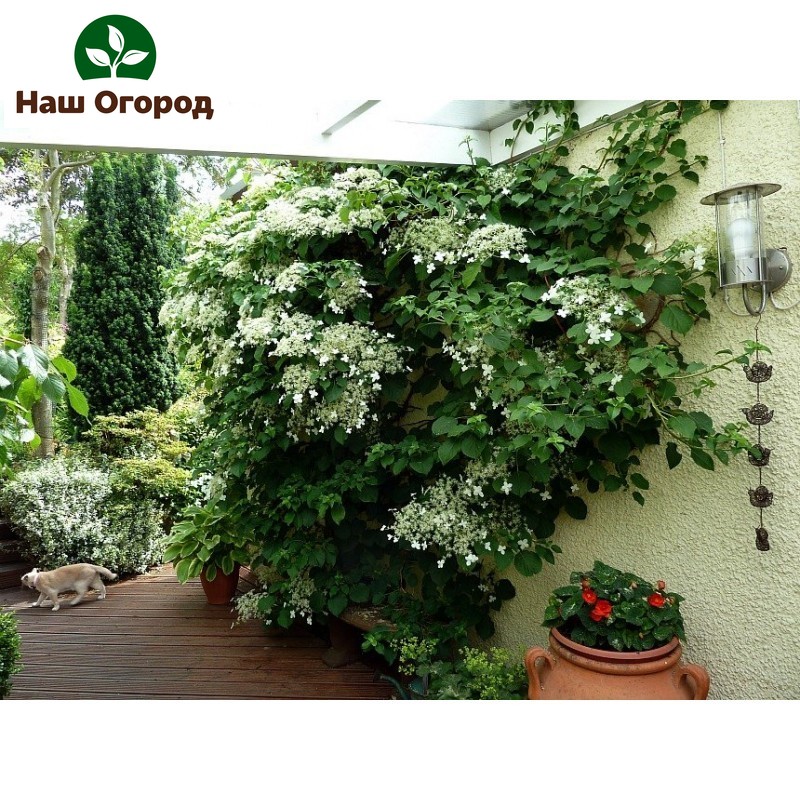Types of hydrangea
Content:

Hydrangea is an extremely presentable decorative shrub, which is almost an integral part of most compositions, finds its place in the design of summer cottages, verandas and buildings, and is used for arranging hedges. We will try to take a closer look at some types of hydrangea, and perhaps some of them will appeal to you.
Hydrangea.
It is a deciduous and upright shrub with a rounded crown, reaching in some cases up to 2 meters in height. The leaves are light green in color, rather large - up to 15 centimeters in length.
White flowers with a cream shade are collected in hemispherical inflorescences, the diameter of which is within 20 centimeters.
Flowering occurs in the second half of July and continues until August. Young plants, especially flowering plants, need to be strapped in order for the inflorescences to be reliably supported. The size of the inflorescences and their number are determined by the quality of the pruning - remember this.
Treelike hydrangea grows most efficiently in well-lit areas, although it also adapts to shade. The advantage of this type is an incredibly fast recovery after severe winter frosts, but in return it makes rather high demands on the level of soil fertility, as well as on its moisture.
The plants are quite beautiful, they are used in the form of group and single plantings, and those that have already dried up are suitable for the composition of winter bouquets. Treelike hydrangea reproduces successfully through root suckers, cuttings, and cuttings.
Ash hydrangea.
This is a rather beautiful shrub with a spreading crown, the height of which can reach 2 meters. The leaves are rather large, the inflorescences of white flowers are marked as corymbose, the diameter is from 8 to 15 centimeters.
Intense flowering with a high level of abundance lasts for a month or more, on average, it is late July - early August. The most decorative form, distinguished by its original appearance, can be noted Sterilis.
Its white inflorescences reach 9 to 16 centimeters in diameter and look very beautiful from the side. Without hilling and covering the hydrangea with covering materials for the winter, the shoots of the ash hydrangea can be frozen, although by the spring season they usually grow back.
It is characterized by the formation of root shoots up to 1 meter high or more, as in the case of the tree hydrangea. This species reproduces by means of layering, offspring, dividing the bush, as well as green cuttings.

Petiolate hydrangea is a shrub that looks like a liana.
Hydrangea ground cover.
A very beautiful type of hydrangea with a high level of decorativeness, but unfairly not as common as the rest, and few summer residents know about it.
It is a deciduous shrub with spreading shoots of reddish and brown shades, which in turn form a rounded crown, reaching up to 2.5 or even 3 meters in height. Leaves are greenish tones, rather large, the length reaches 13 centimeters.
Leaves bloom at a late date, somewhere in mid-May. The flowering process occurs at 6 or 7 years of age of the plant. In the last days of June, the formation of inflorescences-scutes is noted, and full flowering begins already at the end of July.
The process is characterized by a duration of up to three weeks.During the period of abundant flowering, the shrub begins to be covered with white inflorescences in large quantities.
Groundcover hydrangea is valued mainly for the duration, intensity and quality of flowering, ahead of some other species by an order of magnitude. Other advantages include simplicity and resistance to low temperatures and drought.
Stalked hydrangea.
A shrub that looks like a vine. Unlike all other types of hydrangea, it is essentially a liana, but it can also appear in the form of a shrub, the height of which is about 2 meters.
The shoots of the petiolate hydrangea are characterized by the presence of suckers and aerial roots, which allow it to climb to a height of 15 meters or more, using supports or trees for this. It is widely used to decorate both the plot and verandas, beams, windows and so on.
Shoots are able to successfully root when in contact with the ground, the plant holds on confidently. Flowers of greenish-white or pale pink shades contribute to the formation of corymbose inflorescences, the diameter of which reaches a mark of up to 20 centimeters.
Stalked hydrangea is a good honey plant. Caring for this species is not particularly difficult due to the high level of its resistance to low temperatures, but protection should not be neglected at all.
In particularly harsh winters, young plants are at risk of damaging their shoots without proper shelter. In order to prevent them from freezing during frosts and frosts, first of all, it is better to plant a hydrangea in an area that is protected from wind currents from the north and warms up more evenly. It is better to provide southern slopes for this.
Remember that high-quality and intense flowering of a plant is noted only in well-lit areas, and the soil, in turn, must have a sufficient level of moisture and fertility.

